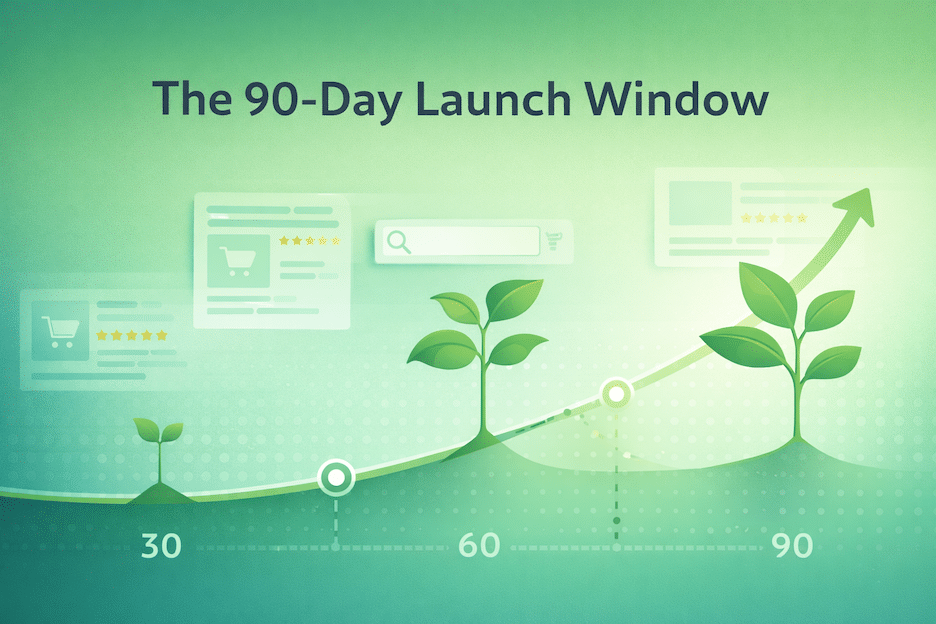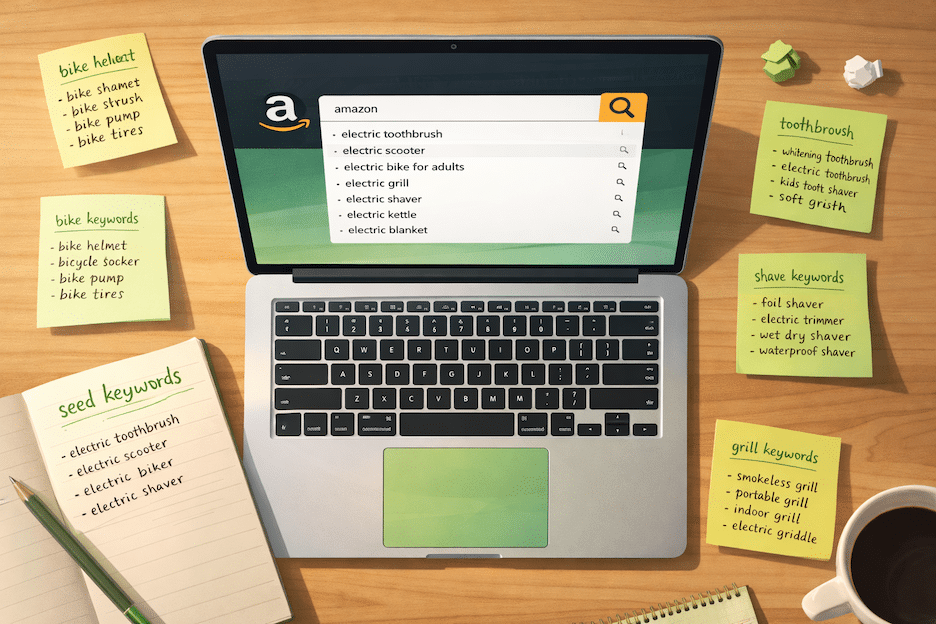7 (Different) Ways to Make Money On Amazon In 2024
Expand Your Entrepreneurial Skill Set, AND Make More Money, Without Leaving Amazon’s Ever-Growing Marketplace!

Today’s online shoppers discover products through a wide range of channels; everything from social media giants like TikTok, and Instagram to a social commerce interaction with a favorite influencer.
That’s why forward-thinking retailers are constantly searching for new ways to grow their ecommerce sales and engage customers across multiple platforms.
Thinking About Hiring an Amazon Management Agency?
Canopy’s Partners Achieve an Average 84% Profit Increase!
Let’s talkFulfillment by Amazon Gets All the Attention
While the Fulfillment by Amazon (FBA) program offers tremendous benefits, smart ecommerce brands know that overreliance on a single platform introduces risk.
Some entrepreneurs are expanding to other online marketplaces like Walmart.com. Others are building out their own websites and sales channels.
While FBA may drive the largest portion of your ecommerce revenue today, it’s a good idea to employ diversification strategies to mitigate risks and possibly unlock additional growth opportunities elsewhere.
But, there’s no reason that you absolutely HAVE to leave Amazon to do that.
As Amazon continues to grow, the options for diversifying your ecommerce strategy have grown right along with it. So, without further delay, here’s a list of seven great new ways to make money on Amazon in 2024.

1. Subscription Boxes
Subscription boxes offer convenience and just enough surprise by delivering a selection of curated products matched to each customer’s interests and needs. Subscribers save time and effort from not having to shop for those items themselves.
For businesses, subscription boxes provide a way to reach new customers and generate recurring revenue from subscriptions.
In 2023 subscription boxes were a $32.9 billion business. By 2027, they are expected to hit $65 billion.
As usual, Amazon has been paying attention. Amazon Subscription Boxes enables qualified sellers to list, sell, and manage their subscription box products on Amazon.com. This is a perfect way to engage new customers, and boost Amazon sales.
You can list and manage all of your Amazon business from a single Professional Amazon seller account. Because of that, the likelihood is high that – in addition to increased sales from the subscription boxes – you’ll be able to drive additional revenue through individual item sales.
Amazon says that, “Amazon Subscription Box sellers must be able to offer a fully-assembled curated subscription box with the ability to support free shipping directly to customers in all 50 states, Guam and Puerto Rico.
Sellers must also have an active Professional seller account on Amazon.com in order to start selling, although it is not required to apply to the program. With recent successes such as Dollar Shave Club, Hello Fresh, and Birchbox, it’s clear that this invite-only program is worth jumping through a few hoops to make happen!

2. Retail Arbitrage
Retail arbitrage is a business model where individuals buy products from retail stores at a lower price and resell them on other platforms like Walmart or Amazon for a profit. The profit is made by taking advantage of price differences between different markets.
It’s traditionally been a great way to get started selling on Amazon with low upfront costs and minimal risk.
To do retail arbitrage, sellers research products to check price variability, sales ranks, fees, and potential profitability. The trick is purchasing products with a high enough price difference to make a profit after Amazon’s fees. Once you receive the inventory, you create an Amazon listing and ship the products to an Amazon fulfillment center.
The key advantages of retail arbitrage are the low barrier to entry, fast start-up time, ease of sourcing products, and no need to launch your own product. The downsides include it being time-consuming to constantly source inventory, a lack of consistency in inventory supply, price wars with other resellers, and potential issues with inauthentic claims from brands.
However, retail arbitrage can provide a steady income stream, especially when combined with other Amazon business models like wholesale or private label. Proper use of product research tools and understanding pricing, sales history, and profit margins are critical for success.
Because there’s very little business infrastructure involved, it’s a quick way to scale up quickly. No overseas shipping challenges and limited storage requirements means that more of your money can be spent on inventory and building your business.
Like its close relative, online arbitrage (that takes advantage of the same model, albeit online instead of in retail stores) it does require a good instinct for trends, and software tools to make it easier to quickly identify low-hanging product opportunities.

3. Sell Handmade Goods
Here’s another path towards the Amazon Buy Box.
Amazon Handmade is a distinct artisan-only marketplace on Amazon that allows artists and crafters to sell their one-of-a-kind, handcrafted products to Amazon’s massive customer base. Because of the strong, creator-based model, it also offers a great opportunity to use social commerce to connect with a particularly niched-down audience.
To sell on Handmade, makers apply and go through an approval process to verify their products are truly handmade. Approved sellers can then create custom storefronts and list unlimited handmade products across 14 categories like jewelry, home goods, artwork and more.
The key benefits include no listing fees (just a 15% referral fee), optional Fulfillment by Amazon, and exposure to Amazon’s billions of shoppers.
When considering whether to sell on Amazon Handmade versus Etsy or other platforms, factors to evaluate include fees, product categories, seller requirements, advertising options, payment schedules, competition levels and customer bases.
To get started on Amazon Handmade, makers submit an application with details on their handmade process, upload product images, choose a category, and must pass Amazon’s verification of their handmade claims.
4. Merch by Amazon
Do you have an artistic streak? Maybe it’s time to become a Merch on Demand content creator.
Merch on Demand’s print-on-demand platform allows artists, designers, and creators to upload their custom designs and sell merchandise like t-shirts, hoodies, phone cases, and more on Amazon without needing any inventory.
Here’s the amazing part, there are ZERO upfront costs!
The key benefits include instant access to Amazon’s massive customer base, potential for passive income from royalties, and bypassing logistical headaches of traditional merchandising. However, it is an invitation-only program with requirements around intellectual property, design standards, and tax information.
To succeed on Merch on Demand, quality original designs aligned with popular trends and niches are crucial, as is effective marketing through optimized listings, promotions, social media, and building an audience. Researching demand, defining a pricing strategy, encouraging reviews, diversifying products, and adherence to Amazon’s policies are also important factors.
While competition exists, the platform offers a relatively low-risk avenue for entrepreneurs and creators to monetize their artwork and ideas by selling customized merchandise worldwide through Amazon’s powerful selling platform.

5. Kindle Direct Publishing
Have a good book idea or a great AI GPT prompt sequence? Amazon’s Kindle Direct Publishing might be the best way to get it printed!
Amazon Kindle Direct Publishing (KDP) enables authors to self-publish eBooks, paperbacks, and hardcover books directly on Amazon’s massive online marketplace for free.
It offers several attractive benefits such as fast publishing within 48 hours, higher royalties up to 70%, complete control over rights and pricing, unlimited free publishing across formats and pen names, and the ability to leverage Amazon’s advertising platform.
KDP provides authors two royalty options based on pricing requirements, and authors can enroll in KDP Select for additional benefits like inclusion in Kindle Unlimited and promotional tools in exchange for exclusivity on Amazon.
To succeed with KDP, optimizing book listings with compelling titles, descriptions, cover images and relevant keywords is crucial for visibility on Amazon’s search rankings. Advertising through Amazon’s sponsored product ads targeting appropriate keywords can also drive discoverability and sales.
The sign-up process is simple, involving creating an Amazon seller account and uploading book content/details. Amazon advertising agencies like Canopy Management can further assist KDP authors with expertise in areas like sponsored ads, creative services, listing optimization and overall strategy to maximize visibility and royalties from their self-published books on Amazon’s massive retail platform.

6. Become an Influencer
There’s no denying that influencer marketing has become a very lucrative platform. In just five years social media marketing grew from $1.7 billion in 2016 to $21.1 billion in 2023.
The rapid growth of influencer marketing has been directly linked to the rising popularity of short-format video on social media platforms such as TikTok, Facebook, and YouTube.
While big brands were the first to get on the influencer trend, there has been a proliferation of smaller, niche-influencers for brands with a more modest footprint.
A study by Lego showed that one-third of 8-12 year-olds aspire to become influencers. Why let the kids have all the fun (and make all the money)?
Once again, Amazon has put their stamp on the process.
The Amazon Influencer Program allows social media influencers, bloggers, and content creators to earn commissions by promoting and driving sales of Amazon products to their target audience.
Influencers apply to the program, create their own custom Amazon storefront filled with products they recommend, and earn a commission (ranging from 1% to 10% based on category) whenever their audience purchases through their influencer campaign links or storefronts.
To become an Amazon Influencer, applicants need an active social media account with a significant follower base of roughly 20,000. The application process involves registering, linking social accounts, creating an Amazon store, and meeting Amazon’s criteria.
Influencer campaigns are promoted through channels like social posts, vlogs, blog content, and leverage tactics like stories, descriptions, and call-to-actions to drive potential customers to their Amazon recommendations.
Tracking results focuses on content metrics like clicks, views and promo code usage. The program provides a lucrative way for influencers to monetize the reach of their ecommerce businesses.
Do you have a social media following? Maybe it’s time to monetize it!

7. Dropshipping
Dropshipping is an ecommerce fulfillment method where the seller partners with a third-party supplier who handles product sourcing, packaging, and shipping orders directly to customers.
You can run your dropshipping business from anywhere with an internet connection. All you need to do is make sure to align with your suppliers and follow up with customers. It’s legal and can be profitable if done correctly by following guidelines and best practices.
To stay on the right side of Amazon’s legal team, a dropshipping business must first set up an Amazon seller account, then be sure to carefully vet and partner with a legitimate dropshipping supplier.
Suppliers should identify the seller as the seller of record, provide proof of authorization to sell products, and handle returns per Amazon’s policies. Sellers remain responsible for customer service, listings optimization, and tracking profitability.
Key tips for dropshipping success include selecting suitable non-perishable products, never giving suppliers account access, calculating all costs for healthy margins, utilizing tools like sales estimators, and considering combining dropshipping with FBA for certain products.
While low startup costs appeal to new sellers, comprehensive planning is still required – researching products, vetting suppliers, understanding policies, handling customer service, and monitoring performance.
When done diligently, dropshipping can be a relatively inexpensive, scalable way to build an ecommerce business by leveraging Amazon’s vast customer base without the overhead of inventory storage.
How Canopy Management Can Help
At Canopy Management, we believe you should be the hero of your own brand story and under the Canopy, you will be! Take a moment to read the success stories of real sellers we’ve helped.
Then, consider one of these strategies, or take a closer look at the Amazon FBA selling platform. Over the last few years, it’s allowed a large number of entrepreneurs to quit their primary job and sell full time.
What would adding 67% more organic sales mean for your brand?
Turns out that when you combine the massive experience of Canopy’s Amazon Advertising Experts with smart tools and tech, you get industry-leading results like this:
- 84% Average Year-Over-Year Profit Growth for Our Partners
- 2.7 Billion in Revenue Managed
- 99.1% Partner Retention Rate
Canopy Management is a full-service marketing agency for Amazon and Walmart sellers. Our team consists of former Amazonians, multi-million dollar sellers, and award-winning experts.
When you consider the many ways that Canopy Management can help you grow your business, you’ll see why selling on Amazon is much easier “under the Canopy.”
- Strategic Growth Planning
- Listing Copywriting Optimization
- Listing Photography
- Product Videography
- Advertising Management
- Customer Service
- Demand Side Platform (Amazon DSP)
- Amazon Posts
- Full Service Management
- Amazon Review Aggregation


